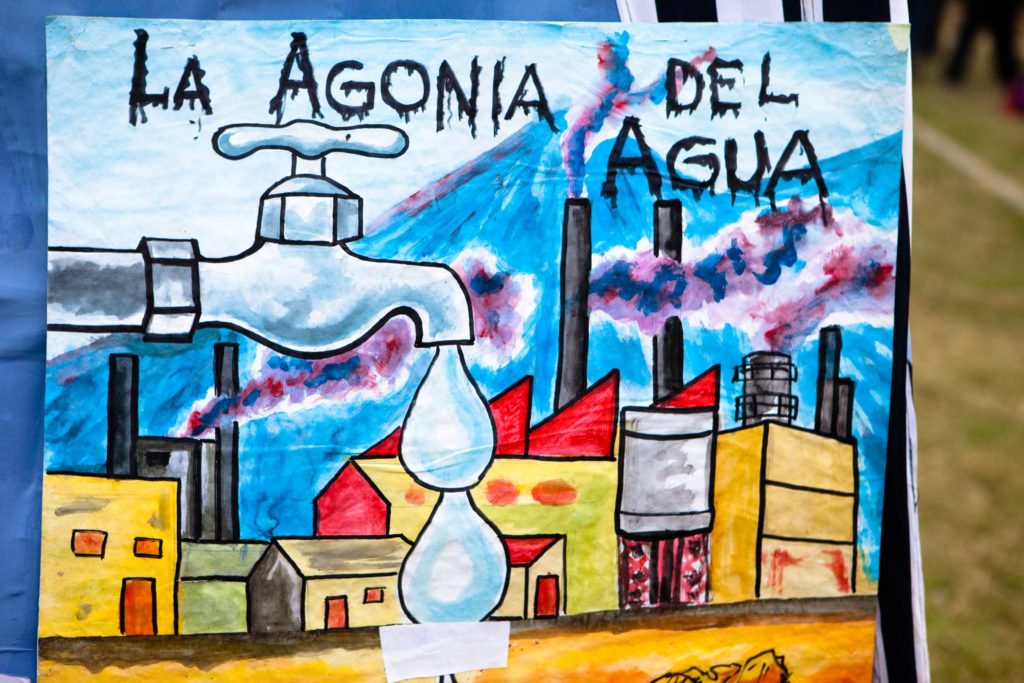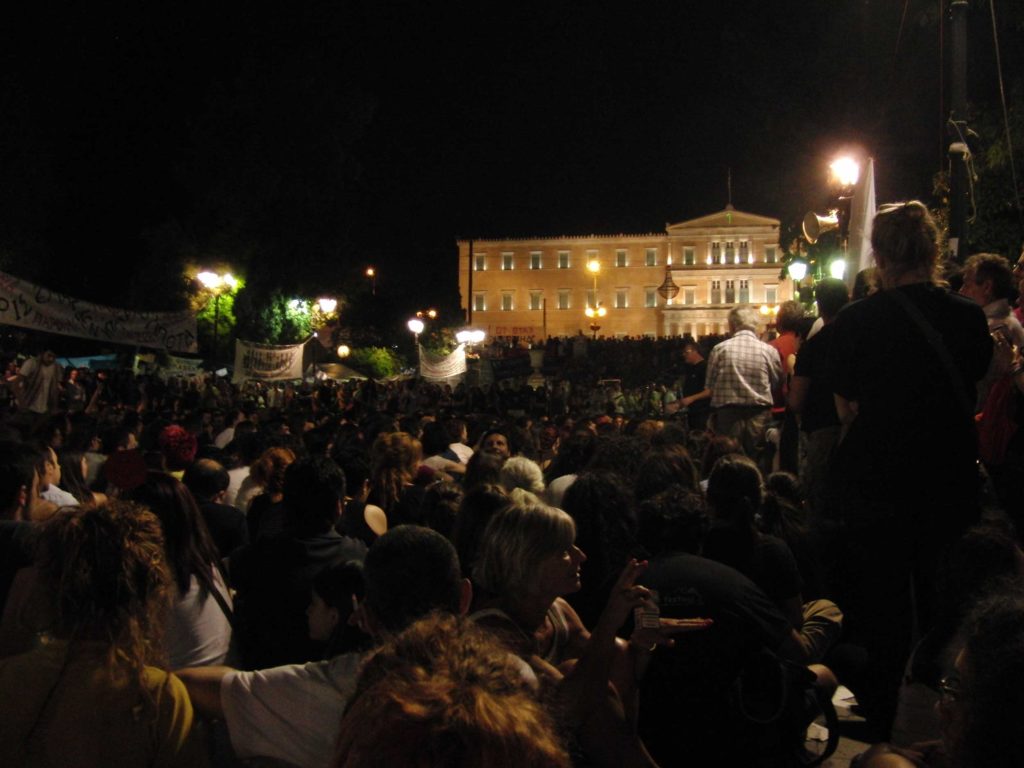Today the concept of ‘the commons’ has become rather a vague notion that is used in contradictory ways. This multifunctional concept has become more and more popularized, having entered into the jargon of both social movements, particularly after the Gezi protests in Turkey, and also into the critical vocabulary of the academic realm. Nonetheless, the concept has virtually become an ‘empty signifier’. In some instances, it is used to describe the sociocultural values of a certain community, while in others it is used synonymously with the concept of ‘right’. The concept of the commons has become one that is resorted to in order to define many movements that arise in various contexts such as discussions of cooperative systems, construction of self-autonomous and self-governing institutions in social reproduction, struggles against the marketization of natural resources, as well as those movements against the commodification of urban space.
Moreover, this concept has been articulated in the last decade by different institutions ranging from the World Bank to non-governmental organizations (NGOs) and government-organized non-governmental organizations (GONGOs). This ‘liberal’ commons approach is based on the claim that the ‘good management’ of natural resources such as water, forests, and land will prove to be profitable for the market and build a barrier against the social disintegration and ecological destruction caused by capitalism. While the enclosure of the commons is an economic necessity for capital, it has also become necessary to create capitalist institutions to deal with social and ecological commons issues that have arisen due to enclosures. Known as the ‘commons fix’, this process refers to the commons being incorporated by the system and thus becoming an integral part of it (de Angelis, 2017).
However, the political debates around the concept of the commons in the 1990s questioned our potential to produce anticapitalist values, norms, and social relations as an alternative to capitalist enclosures that confiscate any kind of social value and relation we produce. The political discourse of the commons envisaged a ‘social revolution’ relying on becoming autonomous from the capitalist system, primarily and particularly in the realm of social reproduction. Therefore, this ongoing struggle of hegemony between the ‘commons of capital’ and social commons obliges us to understand the commons as a critical site of antagonistic struggle where “alternative value practices compete” (de Angelis and Harvie, 2018: 127).
In this paper, I will attempt to map the historical course of the concept of the commons within the framework of the anti-globalization movement beginning in the early 1990s and continuing up to the 2000s and the global movement cycle of 2010-2013 including the Arab Spring and the square and occupation movements. When I was asked to contribute to the discussion about the commons movements in the world, I considered that a paper on the two global movement cycles, of which my generation is the subject, through the lens of the commons, would be appropriate. Such a perspective would obviously not be a comprehensive analysis of both movements since it excludes many important attributes of both movement cycles and the political and theoretical discussion within them. Despite this shortcoming, I believe that looking at these two global movement cycles through the concept of the commons will be fruitful for understanding the internal connections, similarities, and limitations of these movements, which have developed as a reaction against neoliberal globalization. In this regard, this paper attempts to shed light on the interpretation of the commons from the perspective of historical struggles. In doing so, this paper may also serve as a starting point for understanding the impasse such movements are experiencing today.
The return of the commons
In Turkey, the term commons, which was perhaps only used by Marxist economists in connection with the debates on primitive accumulation, began to be addressed particularly in critical social sciences literature starting from the mid-2000s. In that period, we witnessed that areas with the status ‘entailed land’ such as parks, woods in urban areas, and sea shores as well as land and buildings under public ownership, and ‘common resources’ like pastures, meadows, forests, water, and mountains were opened up to enclosure by capital as a result of a series of administrative and legal arrangements enacted in favor of the construction and energy sectors. In response to these attacks, struggles have arisen against mining developments and constructions of hydroelectric and thermal power plants in rural areas as well as the rising opposition against the gentrification of neighborhoods and the selling of the public land and public properties in cities. The notion of the commons has come to define these sorts of new movements. Hence, new collective experiences (struggles, practices, organizations, and patterns of action) that have emerged as a result of the changes in social conditions in the last two decades have all made the word commons a part of critical vocabulary. Having been inspired by historical commons, the word commons has also gained new connotations which encompass comradely words like solidarity, autonomy, horizontality, and collectivism. It therefore presents an oppositional conceptual tool kit in relation to today and for today.
The concept of the commons began to be discussed particularly in autonomist Marxist literature from the 1990s onwards, and rested on the claim that the process of primitive accumulation is inherent to capital accumulation and encompasses continuity rather than a sense of primitiveness.[1] This historical conjuncture reveals that social commons are facing a new round of enclosure and commodification, ranging from the enclosure of intellectual property rights and patent and license rights of genetic material, to the enclosure and commodification of global commons such as air, water, and forests as well as that of cultural commons such as cultural products, heritage, and creativity, and the privatization and marketization of public services (i.e. education, health, water, and electricity) (Harvey, 2004: 123). Discussion of primitive accumulation seemed to be useful particularly for understanding the processes of capital accumulation in the eastern bloc countries, especially after the collapse of the USSR (see Midnight Notes Collective, 1990). However, different struggles were emerging in all parts of the world against the global ‘enclosure movement’. Such struggles were based on the defense of the commons and creation of new commoning practices. Different scales and qualities of movements, ranging from resistance movements against the appropriation of common lands from local communities to the free software movement, started to gain global public visibility. The disappointment felt on the left due to the collapse of the Soviet Union gave way to a short-lived enthusiasm for a new cycle of movement, namely the anti-globalization movement (also known as ‘alternative globalization’, ‘global justice movement’ or the ‘movement of movements’) that lacked an ideological unity.
The anti-globalization movement and the invention of the commons
Dardot and Laval state that the commons is such a category that it allows different and many numbers of struggles “to be all in unison but also to be various, being involved in both a global struggles site while also revealing that they are singular and local” within the anti-globalization movement framework (2018: 94). Indeed, the anti-globalization movement that gained public visibility in the 1999 summit of the World Trade Organization in Seattle, incarnated through the protests against transnational organizations like the IMF, WB, G8, and NATO as well as through the Social Forums, beginning with Porto Alegre 2001, and taking place on different scales, enabled the concept of commons to be revisited and discussed on a global scale. This movement had been shaped by a series of meetings that brought together the movements of the global north and south well before ‘the battle of Seattle’. This movement brought together new social movements that arose in the 70s (ecological, feminist, queer movements, etc.) along with the alternative trade union movements as well as the struggles of south and north with the local and indigenous communities around a single ‘no’ against neoliberal globalization.
Although there exist varying economic and political positions as well as different strategies within the movement, the commons gained visibility owing to the struggles of the global south in particular. Their struggles could be defined as localist, collectivist, or autonomist. Such resistance movements that defend the sovereignty of local communities within the framework of collective production and social rights across different national political systems emerged in particular in Latin America. These local struggles occurred particularly as a result of the enclosure of the natural commons, for example, water, land, seeds, and forests by multinational corporations. These struggles had a prefigurative quality too despite the majority being defensive in nature.
The Zapatistas, who began an armed struggle in January 1994, became a symbol of the commoning movements of the period, with their strategy of communities establishing their own autonomous forms of governance based on the defense of the commons. The Zapatista movement arose in opposition to the annulment of eijido, the regime that allowed for communal land use as stated in the Mexican Constitution. The movement was also opposed to the constraints concerning agricultural production as stated in the NAFTA agreement.

The movement has made gains throughout the years in that the uprising led to the establishment of an autonomous organization structure that is still ongoing in Chiapas. Like many movements in South America, with its resistance to the enclosure of the commons, this movement unites indigenous peoples’ in opposition to colonialism. Intergalactic Encuentros meetings held by the Zapatistas in Chiapas in 1996 and Spain in 1997 led to the emergence of an international activist network called Peoples’ Global Action (PGA). The aim of this network is to establish a network organization opposed to the free trade principles of the WTO, G8, IMF, and WB. In addition, it is also against the global processes of enclosure and appropriation of the commons. PGA brings together the struggles of the north as well as the resistance movements of the global south, for example: large scale movements such as the Landless Peasants Movement in Brazil, Karnataka Farmers Association in India, community organization of the commons such as Quechua and Aymara in Bolivia, whose local community struggles are based on culture and identity, struggles of the local communities that rebelled against land enclosures in Africa, and struggles against dam constructions in India. Yet the movements that defended the commons were not only limited to the rural people’s uprisings in the third world. In the very same time period, the squatters, the homeless, and the poor in Amsterdam, Berlin, New York, and London took to the streets not only for their right to housing per se but in order to reclaim urban commons (Caffentzis, 2004: 5). For instance, Reclaim the Streets was a movement that organized carnivalesque protests on a wide scale from the mid-1990s, intending to reclaim the urban commons in opposition to the privatization of public space and construction of highways. Similarly, the occupy movements in Italy, Germany, and the Netherlands aimed at reclaiming the city as a commons against urban land speculation. Again in the north, the organizations of farmers and producers fighting against patented seeds and GMO are among the important actors of the global movement.

Furthermore, in 2001, factory occupations were carried out in Argentina against the financial crisis; on the neighborhood scale common kitchens and people’s councils emerged. In the same period, mass community protests against the privatization of water resources occurred when water distribution in Cochabamba, Bolivia, was handed over to an American corporation. The experiences in both of these countries brought up discussions regarding the institutionalization of the commons based on organizations and administrations independent of the state and market.
For example, the definition of water as a common in Cochabamba required the creation of the means and institutions for the organization and administration of water autonomous from the market and administration of the state and depending on self-governance on a local scale. The same process applied to the production cooperatives in the occupied factories of Argentina that were abandoned by their owners. Besides this, in the same period, thousands of popular organizations, cooperatives, and community areas, mostly organized by women, emerged in Peru and Venezuela. They engage in food, soil, water, health, and culture. Such solidarist organizations lay the ground for collaborative social reproduction systems that rely on their use value, and autonomy from the state and market (Zibechi 2012). These movements put forward a new type of struggle reliant on creating the new institutions of the commons their defenses.
In her paper Reclaiming the Commons, written during the days of heated alternative globalization movements, Naomi Klein focused on the potential of the movements created by different actors in different geographical locations to reclaim the commons. Such potential was concerned with how they employed new types of activity against neoliberal enclosures:
“As our communal spaces—town squares, streets, schools, farms, plants—are displaced by the ballooning marketplace, a spirit of resistance is taking hold around the world. People are reclaiming bits of nature and of culture, and saying ‘this is going to be public space’. […] European environmentalists and ravers are throwing parties at busy intersections. Landless Thai peasants are planting organic vegetables on over-irrigated golf courses. Bolivian workers are reversing the privatization of their water supply. […] In short, activists aren’t waiting for the revolution, they are acting right now, where they live, where they study, where they work, where they farm” (2001: 51).
Klein emphasizes the prefigurative nature of the anti-globalization movement, that is, its orientation toward establishing the future today rather than wait for a revolution. This demonstrates the prefigurative nature of the movement as the creation of the desired community and collectivism as of today. In this sense, the commoning movements of the period have realized a temporal ‘jump’ in revolutionary strategy, aiming at establishing a ‘dual power’ in the social sphere without ‘putting off things till tomorrow which in fact can be done now’. Scale is the second issue that is related to the debates concerning strategy. Within the movement, as also stated by Klein, a connection is forged between “the state of feeling good locally” and abstract global processes. Here, the idea of scale is based not on a “vertical” but a “flat” spatial imaginary, that is, it is conceived as a ground created by wide ranging movements spreading on all over the globe, as Graham Gibson argues (2010). The global scale of the companies and finance giants and the horizontal and extensive network organization of grassroots movements are parallelized in this way. In addition, resistance movements place emphasis not only on internationalism. They also bring up the relationality between the sectors and struggles. The possibility and potential of a united and transvers struggle including ecological movements, labor movements, and women’s struggles take place within the globalization movement; and in the center of this relationality lie the defense and creation of the commons.
The anti-globalization movement entered a phase of withdrawal after the legendary organization of the global day of protest day in 2003 against the US invasion of Iraq. The European Social Forum that took place in Istanbul in 2010 is seen as the convention that epitomized the demise and burial of the movement. In that period, the commons movements began to carry the risk of becoming internalized and turning into isolated ‘rebel zones.’ The holistic strategic approach of the anti-globalization movement during its heyday seemed to be replaced by isolated and scattered singular movements immersed in place and locality. ‘The paradigm of commons’ that addressed the relationship between global and local as well as that of political and social within the movement was then replaced by micro experiences such as squatting houses and social centers which became isolated in the north after the demise of the movement. As for the south, the movements there were either replaced by alternative institutions, absorbed by the system (as in the problematic relationship between the Landless Workers’ Movement in Brazil and the Labor Party), or they turned out to be isolated experiences that failed to spread their principles outward and became isolated on the national scale, even if they did manage to establish autonomous structures and institutions, as seen in the case of the Zapatistas.

Despite all this, the anti-globalization movement is still important since it has unmasked the inequality and injustice caused by free market sovereignty preached by the neoliberal phase of capitalism. Also, the movement provides an alternative to capitalist globalization. The commoning movements reveal new collective ownership models that supersede the binary of state and private ownership even though private ownership and market mentality expanded and became widespread on a social scale. Thus, social practices and institutions that rely on notions such as reciprocity and decommodification, and principles of solidarity, sharing, and direct democracy are created.
As Dardot and Laval state: “the movements that emerged against neoliberalism united under the name of common constitute a new moment in the history of social struggles given against capitalism.” Even though this moment seemed to have halted, the global cycle of uprisings that occurred during 2010-2013 would become a new beginning that developed the practical and ideological know-how of anti-globalization movement, and began a cycle that would make the commoning movements popular on global scale in a different way.
The 2011-13 movement cycle and the ‘emergent’ commons
The square or occupy movements that emerged in different geographical locations in the aftermath of the protest cycle triggered in Tunisia in 2010 and the Tahrir moment in 2011 are, to say the least, in deadlock today. This cycle, which started as an opposition to neoliberal authoritarian regimes in the east and later led to civil wars and destruction in Bahrain, Libya, Yemen, and Syria, fed into the 2011 large scale square movements in the USA, Greece, and Spain. A cycle of global struggle emerged as a result that included the referendum against water privatization in Italy in the same year as well as student and youth movements that unfolded against the neoliberal university system in Canada, Chile, and the UK. The 2013 Gezi uprising in Turkey, differing movements based on the occupation of city centers in Brazil, Hong Kong, Ukraine, Armenia, Bosnia Herzegovina, and Israel seemed to be the latest wave of this cycle. Each of these movements emerged in their own peculiar social, political, and historical context. However, taken together, they formed an anti-systemic movement cycle that opposed the political, economic, and social outcomes of the global capitalist crisis, contradicting the authoritarian political regimes and financial control processes of the neoliberal order. This movement cycle threw political regimes into crisis in every place it broke out. Yet it is evident that this movement cycle was not strong enough to change the current global system as a whole. These movements have reached a point where it is impossible for them to move under the pressure of the anti-revolutionary powers that emerged to counter the systemic political crisis brought about such movements.
These concurrent movements, which emerged in different geographic locations throughout the world, share a number of commonalities. The occupation of the city centers, the collective action of different political and social groups, patterns of organization without any sort of hierarchy or leader are among the most important political attributes shared by this movement cycle. Defending and establishing what is common is the determining feature of any square movement. This feature corresponds to the “increase in the solution of social reproduction problems through collective solidarity, with these problems being in the way of the communities”. This is named “the development of the commons” by Angelis (2017: 252). It would therefore be apt to discuss here the significance of the commons that has developed within these movements’ framework as well as their limitations and shortcomings, rather than discussing individually the particular patterns of this cycle of movement in their own geography.
The anti-globalization movement, reliant on the ‘scale jumping’ strategy between the global and local scales, head towards national and then local level politics in the 2011-13 cycle. When compared with the previous movement cycle, the movement of the squares did not oppose the neoliberal processes or the determining actors of such processes such as corporations and transnational financial institutions. What they are opposed was the manifestations of these processes as experienced on their own national level. This cycle, compared to anti-globalization movements whose actors are mostly local and rural resistance movements, appears to carry an urban quality. One of the basic dynamics that triggers the movements is the intensifying commodification processes of urban space, and these movements are tightly embedded in the urban space. For this reason, many square movements ‘jump’ to the neighborhood level when the occupation comes to an end. No doubt, this situation does not render these movements ‘national’. In fact, the cycle carries a ‘sincere and heartfelt’ internationalism even though it lacks the aspect of having global concurrence or organizational quality. Nearly every movement establishes a symbolic alliance with its own struggle on a national scale and with other struggles. For example, those who occupied the Madison Wisconsin State Capitol after the US Wisconsin State Senate and voted to curb the collective bargaining rights of public workers sent their regards to Tahrir. The Spanish, inspired by Tahrir, occupied the squares and prepared a banner that read “let’s talk silent do not to wake the Greeks.” Their whispers found a response in Athens upon the occupation of Syntagma square. A new slogan was invented in Israel: “Tel Aviv, Cairo, the same revolution.” In Taksim square a banner stated that the square is Tahrir right here and a Brazilian flag was waved. “Love is over. This is now Turkey” became the motto of the uprising in Brazil. The squares are both a physical common site for this movement cycle and they are also a metaphor for a common movement.

Peter Waterman (2001) used to take the potential of anti-globalization movements seriously. This potential was concerned with the movements of anti-globalization forming a new internationalist movement. Perhaps one of the reasons for the regression of the movement was due to the fact that such a possibility had been overlooked. It can be claimed that today the 2011-13 movements carried a transnational sense of solidarity, and the idea of commons made up the emotional structure of this cycle, defined by Raymond Williams as ‘emergent’.
Williams tells us that “no mode of production and therefore no dominant social order and therefore no dominant culture ever in reality includes or exhausts all human practice, human energy, and human intention… For there is always, though in varying degrees, practical consciousness, in specific relationships, specific skills, specific perceptions, that is unquestionably social and that a specifically dominant social order neglects, excludes, represses, or simply fails to recognize.” (Williams, 1990:100). By ‘emergent’, he is referring to the processes of creating new meanings and values, new practices, new relationships and kinds of relationship (1990:100). The 2011-13 movement cycle has such an emergent global practical consciousness and a world of meaning.
The Invisible Committee reports the following about one of the Tahrir Square ‘citizens’: “Since nothing was working properly any more, everybody started to pay attention to those around. People assumed the responsibility of collecting garbage, they swept the sidewalks and at times repainted them. They drew frescos on the walls and looked after each other. …At Tahrir, people would arrive and spontaneously ask what they could do to help. They would go to the kitchen or to a stretcher…They would work on banners, shields or slingshots, join discussions and make up songs” (2015: 232). Douzinas states that people have similar shared experiences in all the places where square movements emerged, and adds that “this is an extraordinary metamorphosis shared by people in different parts of the world, which has changed them from obedient subjects of law to resisting subjectivities” (2014: 79). What is in question is the ‘emergent’ global experience that is commoning public spaces and is based on decommodification at a time when the neoliberal accumulation of capital has expanded and the state has withdrawn from social reproduction and public services such as housing, education, and healthcare—services which were won by social movements but have now been exposed to marketization. This global experience is an emergent one that strives to organize these sites through solidarity-based relationships and realizes that in a trial and error manner. These kinds of temporary utopian experiences show us that fulfilling the concrete social needs, namely organizing the realm of social reproduction, is itself a political issue, creating a social antagonism which has a class-based attribute. Such a perspective leads us to understand square movements as relational and process-oriented rather than seeing the movements as a system of values or as a resource in which the commons are given. It also leads us to understanding them as the production of new social relations and subjectivities through collective practices and struggles. Following Williams, the new experiences that emerged in the squares and their material foundation attain a term that will name these experiences.
Badiou, in a paper written during the very first days of the Tahrir Square occupation, describes Tahrir as a universal phenomenon, stating that:
“In the wake of an event, community is made up of those who are knowledgeable in resolving the problems posed by the event. The same applies for the occupation of a square. A place where all things happen. A place which has become a symbolic one, and all the chores to be conducted so that the place can remain to be the property of public. These chores include requires food and sleeping arrangements, ensuring safety, and prayers…. The solution of the unsolvable problems without the help of the state is the destiny of that event” (2011).
In fact, the destiny of the square movements converged on the daily social practices that constitute the rhythm of the occupation. These practices are caring for each other, dealing with food and cleaning, making tea, sleeping, having a chat, listening, discussing, taking care of the wounded, or organizing logistics and maintaining safety. Both in Tahrir and Taksim, these new reproduction practices, from food to care, associated with the private sphere of social life were moved and relocated to the public sphere. These actions were revolutionary not just because they rendered the occupation continuous, but because their revolutionary character was due to the fact that this site was organized in a way which excluded the state and the market.
Afterlives
Within the anti-globalization movements, the practices of commoning viewed virtually as a survival strategy for the marginalized urban and rural communities—the local communities in colonial states in particular—were also put on the political agenda of those attributed as privileged in terms of culture and social status. This inclusion in the agenda was seen through the 2011-13 cycle. Nonetheless, carrying the ‘commoning moment’ in the squares to a point beyond a single ordinary ‘moment’ of the occupation, seems to be the Achilles’ heel of the issue. For example, Asef Bayat describes Tahrir as an exceptional moment within a long process of revolution that occurs in most of the great revolutionary transformations where practices emerged to go back and forth between real and unreal as well as between reality and utopia (2013). The real problem for Bayat, however, is “what happens the day after the dictator abdicates, and people go home to fulfill normal daily needs such as getting bread, jobs and safety” (2013). It is not possible to provide a complete answer to this question within this paper. Yet we can say that the period after that ‘moment’ comes to an end is the real starting point of the struggle.
In that case, we need to mention two aspects of these movements. The first aspect is the patterns of social relationality that are self-governing and outside the market as they emerge upon the occupation of space. In other words, it is the collective practices, meaning and values that commonizes the occupied space. The second aspect is the revealing of collective patterns of action and organization that will relocalize the world of practices and meaning on different scales on the temporal axis. Even though the future of the square movements varied depending on the historical, social, and political context in which they emerged, we can say that each movement faced a counter revolution. Thus the course each movement took differed under political violence and social pressure. For example, following Tahrir and Mubarek’s abdication, the processes of counter-revolution, which were shaped by the establishment of Muslim Brotherhood government and later the military coup, seem to make the square movements both dispersed and passivized. Despite these developments, Asef Bayat (2013) emphasizes the significance and novel quality of independent unionization inclinations of small farmers and autonomous youth organizations that were realized in the slums of Cairo after Tahrir. Bayat states that the ‘emergent’ mass revolutionary aspirations that are geared towards emancipation, self-actualization, and the establishment of a new order contradict the political elites’ aims of order and stability. For this reason, there emerges the need for them to withdraw and this conflict is the determining anomaly of the global movement.
On the other hand, we witness the rise of solidarity movements and a process in which commoning practices became institutionalized, particularly during the financial crisis after the occupation of Syntagma Square in Greece. Collective kitchens, solidarity pharmacies, social clinics, solidarity schools, cooperatives, producer-consumer networks, barter markets, time banks, and city gardens, which are among the solidarist, collaborative, equalitarian, self-governing, and democratic institutions of the common, enabled communities to survive during the ongoing crisis. As Çetinkaya (2016) notes, these institutions also create the grounds of an alternative social organization based on commoning as much as solidarity and reciprocity principles allow, rather than just being reliant on philanthropy.

What is important for us, if we are to put it in Fevzi Özlüer’s terms, is that commoning is grounded on the principle of ‘practicability’, which renders individuals doers and subjects, rather than being based on ‘accessibility’ to food, medicine, education, or housing.[2]
The 15-M Occupy movements in Madrid and Barcelona, emerged as opposition to the 2008 financial crisis, and were fed by the autonomous movements from the earlier cycle of anti-globalization movement that is still healthy in both these cities. After people in the squares dispersed, the movements spread, on the one hand, toward neighborhood organizations, and parliamentary and local politics, on the other (Podemos and Ganemos). As Castells (2013) puts it, once the squares become empty, the movement aims at mobilizing different forms of organizations, such as neighborhood councils, consumer cooperatives, ethical banking, and barter networks that will make life more meaningful. On the other hand, the square movements gave rise to the Barselona en Comu (Common Barcelona) movement that managed to get hold of the local administration. This municipalist movement is seen as a critical threshold as to how the relation between local administration and commoning movements is to be institutionalized.
Despite not being a square movement per se, the commons’ struggle in Italy, known as beni communi, has been going since the 2000s and is based on the accumulation of anti-globalization movements. In the water privatization referendum in 2011, the law was vetoed (56% of participation, with more than 90% of no votes), and eventually it resulted in a win since water was defined as a commons and social services would not be privatized. Besides this, the occupation of Teatro Valle in Rome paved the way for commoning practices in the sphere of culture; the No-TAV struggle against the construction of a high-speed train in the Susa Valley triggered yet more struggles in different cities for preserving the ecological commons. Commoning movements bringing grassroots movements together with that of institutional legal activism and municipalism are becoming stronger in Italy, with Naples being the center of such efforts.

Dardot and Laval agree with David Harvey when he points to “a sort of phobia of hierarchy, even phobia of organization and the idealization of horizontal organization of political action” seen commonly in square movements. According to Dardot and Laval, “ as seen in the cases of Occupy Wall Street and Indignados, these attitudes have sometimes led to political impasses and demoralizing failures because they cannot create sustainable organizational models suitable for the object of the movements and the object of their demands” (2018: 142). Similarly, Asef Bayat (2013) states that the Tahrir ‘moment’ could not imagine what would lie beyond that particular ‘moment’ and that this lack of imagination and organization happen to be the fundamental attributes of the 2011 movement cycle and square movements. It seems that these movements are bound to lose unless they can create their self-organizing ‘institutions of the commons.’
It would be beneficial to view the movements of commoning that emerged in the two global movement cycles discussed in this paper, through the perspective provided by the famous slogan of Gezi: ‘this is just the beginning’. Therefore, they should not be regarded as an outcome or an ultimate target, but a beginning. It is clear that the commoning movements within both of the movement cycles do not put forward a political revolutionary strategy in any recognizable sense. Nevertheless, these movements incorporate the core of a social revolution based on the institutionalization of commoning practices.[3] In this way, theoretical and practical discussion on the commons provides a paradigm of social transformation that is based on the production of alternative practices, relations, meanings, and values in socio-cultural and economic realms. Therefore, we are faced with a macro strategy that foresees the establishment of a ‘dual power’ in the social sphere, i.e. the construction of a conflict between capitalist and anti-capitalist institutions, relations, practices, and values. However, there lies a discrepancy between the micro level of the commoning movements within these two movement cycles and this macro strategy. This discrepancy requires the creation of a medium-level ground. Otherwise, micro experiences carry the risk of becoming new communitarian communities. Currently, the relation being established between the new municipality practices and commoning movements seems to carry the potential for creating such a mezzo level on condition that such local administrative actions should rise from the grassroots movements.
Commoning practices, such as production cooperatives of blue collar and white collar workers, non-commercial health centers and nurseries, sports associations, radio stations, and many more, can have a mobilizing effect in a period when leftist and socialist opposition cannot not make an organized and progressive political move. Besides, creating modest institutions of the common and making connections among institutions carries a crucial importance to most of us when the economic crisis has such a huge impact on daily life. The ‘emergent’ idea of the commons, as it emerged from within the global movement cycles in response to the economic, social, and ecological destruction of capitalism, offers a good starting point both for the survival of the planet and also for establishing an ethical common life for all.
Notes
[1] For papers of autonomous Marxist thinkers like Massimo de Angelis, Silvia Frederici, George Caffentzis and Werner Bonnefeld on commons, see The Commoner journal: www.commoner.org.uk. For a good compilation that defends the sustainability thesis, see Özay Göztepe (compiled., 2014).
[2] I used the term with reference to another discussion that was brought up by Fevzi Özlüer in the “Commons Working Group” meeting held in Mersin Kültürhane on July 28-29, 2018.
[3] For a paper that discusses the difference between social and political revolution from the perspective of commons, see De Angelis (2014).
References
Badiou, A. (2011). “Tunisie, Egypte : quand un vent d’est balaie l’arrogance de l’Occident”. Access: https://www.versobooks.com/blogs/394-alain-badiou-tunisie-egypte-quand-un-vent-d-est-balaie-l-arrogance-de-l-occident
Bayat, A. (2013). “Revolution in Bad Times”. New Left Review. Access: https://newleftreview.org/II/80/asef-bayat-revolution-in-bad-times
Caffentzis, G. (2004). “A Tale of Two Conferences: Globalization, the Crisis of Neoliberalism and Question of the Commons”. Access: http://www.globaljusticecenter.org/papers/caffentzis.htm
Caffentzis, C ve Federici, S. (2014). “Commons against and beyond capitalism”. Community Development Journal, 92-105.
Castells, M. (2013). İsyan ve umut ağları: İnternet çağında toplumsal hareketler. İstanbul: Koç Üniversitesi Yayınları.
Çetinkaya, D. (2014). “Yunanistan’da toplumsal hareketler ve kolektif deneyimler (2009-2015): Sosyal mutfaklar, sosyal klinikler ve zaman bankaları”. Birikim, 321: 39-48.
Dardot, P. ve Laval, C. (2018). Müşterek: 21. Yüzyılda Devrim Üzerine Deneme. İstanbul: İstanbul Bilgi Üniversitesi Yayınları.
De Angelis, M. (2007). The Beginning of History: Value Struggles and Global Capital. Londra: Pluto Press.
De Angelis, M. (2012). “Crises, capital and cooptation: Does capital need a commons fix?”. içinde D. Bollier ve S. Helfrich (Ed.), The Wealth of the Commons: A world beyond market and state. Amherst, MA: Levellers Press.
De Angelis, M. (2014). “Social Revolution and the Commons”. South Atlantic Quarterly. 113 (2): 299-311.
De Angelis, M. (2017). “Krizler, Hareketler ve Müşterekler”. F. Adaman, B. Akbulut ve U. Kocagöz (ed.). Herkesin Herkes için: Müşterekler Üzerine Eleştirel bir Antoloji. İstanbul: Metis Yayınları.
Douzinas, C. (2014). “Notes Towards an Analytics of Resistance”. New Formations 83, 79-98.
Göztepe, Ö. (Ed.) (2014). İlkel Birikim: Sermayenin Kaldıracı. Ankara: Nota Bene Yayınları.
Graham-Gibson, J. (2010). (Bildiğimiz) Kapitalizmin Sonu: Siyasal İktisadın Feminist Eleştirisi. İstanbul: Metis.
Harvey, D. (2004). “El Koyarak Birikim”. Yeni Emperyalizm. Trans. Hür Güldü. Everest Yayınları, 74-175.
Klein N. (2001). “Müşterek Olanı Yeniden Ele Geçirmek”. Birikim: 50-55
Midnight Notes Collective. (1990). “The New Enclosures”. New Enclosures. New York: Autonomedia.
The Invisible Committee. (2015). To Our Friends. Semiotext(e).
Waterman, P. (2001). Globalization, Social Movements, and the New Internationalism. A&C Black.
Williams, R. (1990). “Egemen, Kalıntısal, Doğmakta Olan”. Marksizm ve Edebiyat. İstanbul: Adam Yayınları, 87-101.
Zibechi, R. (2012). Territories in Resistance: A Cartography of Latin American Social Movements. Oakland: AK Press.
Photo Credits (in sequential order)
Indignats / Indignados / Indignés ![]() by Julien Lagarde, Acampada, Barcelona, 21/05/1011
by Julien Lagarde, Acampada, Barcelona, 21/05/1011
Indignats / Indignados / Indignés ![]() by Julien Lagarde, Acampada, Barcelona, 21/05/1011
by Julien Lagarde, Acampada, Barcelona, 21/05/1011
Indignats / Indignados / Indignés ![]() by Julien Lagarde, Acampada, Barcelona, 21/05/1011
by Julien Lagarde, Acampada, Barcelona, 21/05/1011
Indignats / Indignados / Indignés ![]() by Julien Lagarde, Acampada, Barcelona, 21/05/1011
by Julien Lagarde, Acampada, Barcelona, 21/05/1011
Feria Internacional del Aqua – 10 year anniversary of Cochabamba Water Wars – Bolivia ![]() by kris krüg
by kris krüg
Indignats / Indignados / Indignés ![]() by Julien Lagarde, Acampada, Barcelona, 21/05/1011
by Julien Lagarde, Acampada, Barcelona, 21/05/1011
Indignats / Indignados / Indignés ![]() by Julien Lagarde, Acampada, Barcelona, 21/05/1011
by Julien Lagarde, Acampada, Barcelona, 21/05/1011
Indignats / Indignados / Indignés ![]() by Julien Lagarde, Acampada, Barcelona, 21/05/1011
by Julien Lagarde, Acampada, Barcelona, 21/05/1011
Indignats / Indignados / Indignés ![]() by Julien Lagarde, Acampada, Barcelona, 21/05/1011
by Julien Lagarde, Acampada, Barcelona, 21/05/1011
People’s Assembly at Syntagma (=Constitution) Square ![]() by Ιωάννης Πρωτονοτάριος
by Ιωάννης Πρωτονοτάριος
Indignats / Indignados / Indignés ![]() by Julien Lagarde, Acampada, Barcelona, 21/05/1011
by Julien Lagarde, Acampada, Barcelona, 21/05/1011

Begüm Özden Fırat is currently a faculty member at Mimar Sinan Fine Arts University, Department of Sociology. She studied urban and cultural sociology, visual culture, and culture and social movements. She is an editor of the books entitled Commitment and Complicity in Cultural Theory and Practice (Palgrave/Macmillan, 2009), Cultural Activism: Practices, Dilemmas, Possibilities (Rodopi, 2011) and Resistance and Aesthetics in the Age of Global Rebellion (Küresel Ayaklanmalar Çağında Direniş ve Estetik, 2015, İletişim). Her book entitled Encounters with the Ottoman Miniature: Contemporary Readings of an Imperial Art was published in 2015 by I.B. Tauris.